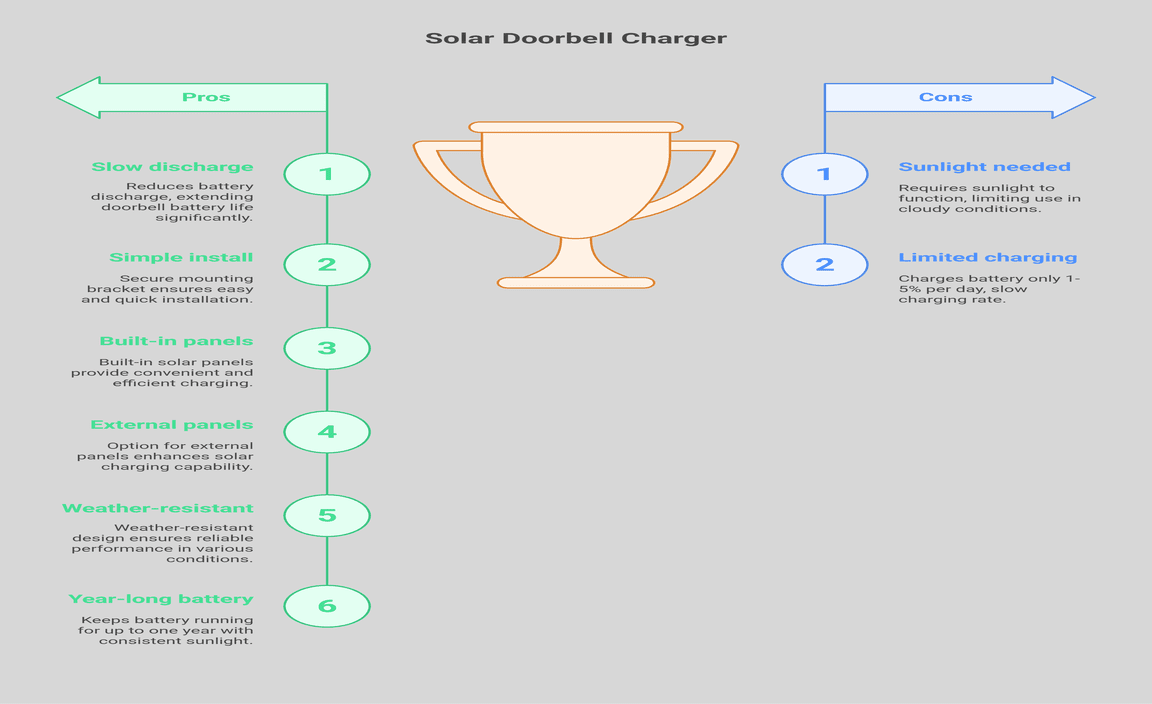A Ring Plug-In Adapter for a Wired Doorbell is the perfect fix when you don’t have existing doorbell wiring or need a simpler power solution. It connects your Ring wired doorbell directly to a standard wall outlet, eliminating the need for complex electrical work and ensuring your smart doorbell is always powered and ready.
Ever wanted to install a Ring wired doorbell but felt stuck because of missing or non-existent doorbell wires? It’s a common frustration! Many homes, especially older ones, weren’t built with traditional doorbell wiring. This can make setting up a smart doorbell seem like a daunting, expensive project. But what if there was a simple, safe, and straightforward way to get your Ring doorbell powered up without touching a single wire in your wall? There is! We’re going to walk you through exactly how a Ring plug-in adapter can be your essential fix, making installation easy for anyone. Get ready to enjoy the peace of mind and convenience of your smart doorbell, no electrician needed.
Why You Might Need a Ring Plug-In Adapter
Traditional wired doorbells rely on a low-voltage electrical current that runs from a transformer, through your walls, and to your doorbell button. This system is standard in many newer homes, but it’s often absent in older properties, apartments, or even some DIY renovations. Without this existing wiring, powering a wired Ring doorbell directly becomes a challenge. You might also have existing wiring that’s faulty, incompatible with smart doorbells, or simply inconveniently located. This is where the Ring plug-in adapter shines.
The Missing Wire Problem
The most frequent reason a plug-in adapter is needed is the outright absence of any doorbell wiring. When you purchase a wired Ring doorbell (like the Ring Video Doorbell Wired or the Ring Video Doorbell Pro), it’s designed to be hardwired. If you unbox it and look for the existing wires to connect to, and find… nothing, you’re not alone. This isn’t a dealbreaker; it just means you need an alternative power source. The plug-in adapter is that alternative.
Incompatible or Damaged Wiring
Sometimes, wiring might exist, but it’s not suitable for a smart doorbell. Older systems might use different voltage levels or configurations that aren’t compatible. In other cases, the wires could be damaged, corroded, or simply too short to connect conveniently. Trying to splice together old, brittle wires can be risky and might not provide stable power. The plug-in adapter bypasses these issues entirely by giving you a direct, reliable power source from a nearby outlet.
Convenience and Ease of Installation
Let’s be honest, electrical work can be intimidating for beginners. Running new wires through walls involves drilling, fishing wires, and potentially understanding building codes, which can be a significant barrier. The appeal of a plug-in adapter lies in its simplicity. It transforms a potentially complex DIY job into a quick setup that almost anyone can do. You get the features of a professional-looking wired doorbell without the hassle or the cost of hiring an electrician.
What is a Ring Plug-In Adapter?
At its core, a Ring plug-in adapter is a piece of hardware that takes the standard AC power from your household wall outlet (typically 110-120V) and converts it into the lower-voltage DC power that your Ring wired doorbell requires to operate. It’s essentially a smart, compact transformer that plugs into an outlet and then connects to your doorbell using a separate, often longer, cable. This cable then runs to your Ring doorbell, providing it with continuous power.
How the Adapter Works
Think of it like the power brick for your laptop or gaming console. It’s a bridge between the high-voltage power grid in your home and the low-voltage electronics of your Ring device. The adapter contains circuitry that safely steps down the voltage and modifies it to the correct type (AC to DC). This ensures your doorbell receives the stable, consistent power it needs to function, from streaming video to sending motion alerts, without interruption. Many Ring plug-in adapters also come with a generous length of cable, giving you flexibility in where you place the outlet relative to your doorbell.
Key Components
When you get a Ring plug-in adapter kit, here’s what you’ll usually find:
- The Power Transformer/Adapter Unit: This is the main part that plugs into your wall outlet. It’s typically a small, rectangular box.
- Power Cable: A long cable (often 20-30 feet) that connects from the adapter unit to your Ring doorbell. This cable delivers the converted power.
- Wire Connectors: Small clips or terminals that attach the adapter cable’s wires to the back of your Ring doorbell.
- Installation Hardware: Sometimes, these kits will include screws or mounting plates to help secure the adapter or route the cable.
Choosing the Right Ring Plug-In Adapter
Not all Ring doorbells are created equal, and neither are the adapters. It’s crucial to get an adapter specifically designed for your Ring wired doorbell model. Using an incompatible adapter can lead to your doorbell not working, or worse, damaging the device or creating a safety hazard.
Compatibility is Key
Ring offers several wired video doorbells, and each might have slightly different power requirements. The most common models that utilize plug-in adapters include:
- Ring Video Doorbell Wired: This model requires a wired power source and is often paired with a plug-in adapter.
- Ring Video Doorbell Pro / Pro 2: These higher-end models draw more power and require specific adapters or hardwiring kits that can handle their needs.
Always check the product packaging or the official Ring website for compatibility information. On the Ring.com site, you can usually find detailed specifications for each device and recommended accessories. For instance, the Ring Video Doorbell Wired is designed to work seamlessly with the Ring Plug-In Adapter (2nd Gen) or a compatible transformer that provides 16-24V AC power.
Ring Official vs. Third-Party Adapters
While it might be tempting to save a few dollars on a third-party adapter, it’s generally best to stick with official Ring accessories. Official adapters are rigorously tested to meet Ring’s specifications, ensuring optimal performance and safety. Using a non-certified adapter could void your Ring device’s warranty and may not provide the stable power needed for consistent operation. For a device that’s your first line of home security, reliability is paramount.
Power Specifications to Watch For
Ring wired doorbells typically require a power supply that delivers between 16-24 Volts AC (VAC). The amperage (the amount of electrical current) also matters. A common requirement for the Ring Video Doorbell Wired is a transformer that outputs 10VA (Volt-Amperes) or higher. For more advanced models like the Pro or Pro 2, you might need a transformer capable of 30-40VA. The plug-in adapter takes care of this conversion, but it’s good to know what your doorbell needs.
A helpful resource for understanding power requirements for smart doorbells can often be found on electrical safety sites or manufacturer support pages. For example, the U.S. Consumer Product Safety Commission (CPSC) provides general guidance on electrical safety in the home, which can be a useful background reference for any DIY electrical project.
Steps to Install Your Ring Plug-In Adapter and Wired Doorbell
Installing a Ring wired doorbell with a plug-in adapter is a satisfying DIY project. It typically takes less than an hour and requires minimal tools. Let’s break it down.
Step 1: Gather Your Tools and Materials
Before you start, make sure you have everything you need. This will make the process much smoother.
- Your Ring wired doorbell
- The compatible Ring plug-in adapter
- A screwdriver (usually Phillips head)
- A drill with appropriate drill bits (if mounting the doorbell to a surface)
- Wire strippers (sometimes needed if the adapter cable isn’t pre-stripped)
- A level (optional, but helpful for a straight mount)
- A pencil for marking
- The Ring app downloaded to your smartphone or tablet
Step 2: Set Up Your Ring Device in the App
It’s usually easiest to set up your Ring doorbell in the app before you mount it. This way, if you run into connection issues, you can troubleshoot without being on a ladder.
- Open the Ring app.
- Tap “Set Up a Device.”
- Select “Doorbells.”
- Scan the QR code on your Ring doorbell or its packaging.
- Follow the on-screen prompts to connect your doorbell to your Wi-Fi network.
Step 3: Connect the Plug-In Adapter to Power
Find a suitable wall outlet that is close enough to where you want your doorbell to be located, but also conveniently accessible for the adapter. This outlet should be within your Wi-Fi range.
- Plug the adapter unit into the wall outlet.
- Route the long power cable from the adapter towards the location of your Ring doorbell. You can often use existing door frames or trim to hide or secure the cable.
Step 4: Mount Your Ring Doorbell
Now, you’ll attach the Ring doorbell itself.
- Determine Placement: Ring recommends mounting doorbells between 3.5 and 4 feet (around 1.0 to 1.2 meters) from the ground for optimal motion detection and facial recognition.
- Mark Mounting Holes: Hold the mounting bracket against the wall (or doorframe) where you want the doorbell to go. Use a pencil to mark the screw hole locations. A level can help here.
- Drill Pilot Holes (if necessary): If you’re mounting into wood, you might be able to screw directly in. For harder surfaces like brick or stucco, you’ll need to drill pilot holes and insert wall anchors (make sure to use anchors suitable for your wall type and the weight of the doorbell).
- Secure the Mounting Bracket: Screw the mounting bracket firmly to the wall using the provided screws.
- Mount the Doorbell: Align the Ring doorbell with the bracket and slide it into place until it clicks or feels securely attached.
Step 5: Connect the Power Cable to the Doorbell
This is the final electrical connection. Ensure the power cable is long enough to comfortably reach the back of the doorbell from the adapter.
- Locate the two small terminals on the back of your Ring doorbell.
- Take the two wires from the end of the plug-in adapter’s cable. Often, these wires are already stripped. If not, use wire strippers to expose a small amount of bare wire at the end of each.
- Wrap one wire around one terminal screw and the other wire around the second terminal screw.
- Tighten the screws firmly to secure the wires. It doesn’t matter which wire goes to which terminal for AC power.
Step 6: Final Checks and Testing
Once everything is connected, it’s time to test.
- Ensure the doorbell is properly seated on its mounting bracket.
- The Ring doorbell should power on. You’ll likely see an indicator light or hear a chime or boot-up sound.
- Use the Ring app to ring the doorbell (you might need to physically press the button or there might be a testing function in the app).
- Check if you can see live video, hear audio, and receive notifications on your phone.
If everything works perfectly, congratulations! You’ve successfully installed your Ring wired doorbell using a plug-in adapter. If not, double-check your connections, ensure the adapter is plugged in, and review your Wi-Fi signal strength in that location.
Pros and Cons of Using a Plug-In Adapter
Like any solution, the plug-in adapter method has its advantages and disadvantages. Understanding these can help you decide if it’s the right path for your smart doorbell setup.
Advantages
- Simplicity and Ease of Installation: This is the biggest win. No need to run wires through walls or understand complex electrical systems.
- No Existing Wiring Needed: Perfect for homes or apartments where traditional doorbell wiring is absent.
- Cost-Effective: It’s significantly cheaper than hiring an electrician to run new wires.
- Flexibility in Placement: You can place the doorbell closer to your door, as long as there’s a nearby accessible power outlet.
- Reliable Power Source: When used correctly, it provides a consistent power supply, preventing battery drain issues common with some other smart devices.
- Reversible: If you’re renting, this method is non-permanent and doesn’t involve altering the building structure.
Disadvantages
- Visible Cable: The power cable running from the outlet to the doorbell might be unsightly, depending on your installation. You’ll need to find ways to conceal or tidy it.
- Outlet Dependency: Your doorbell’s power is tied to the outlet. If the outlet loses power (e.g., due to a power outage, or if the circuit breaker trips), your doorbell will stop working.
- Limited Outlet Availability: You need a conveniently located outlet near the doorbell’s mounting spot. If the nearest outlet is very far, the cable length might be an issue, or the visual clutter could be significant.
- Potential for Aesthetic Compromise: While you can hide wires, it might not look as clean as truly hardwired installations.
Tips for Hiding the Power Cable
The main drawback of a plug-in adapter is the visible cable. Here are a few practical ways to minimize its appearance:
- Use Cable Management Solutions: Invest in adhesive cable clips, raceways, or sleeves. These can be painted to match your walls or trim and help guide the cable neatly along baseboards, doorframes, or window sills. You can find these at most hardware or electronics stores.
- Underneath Carpeting or Rugs: For longer runs across floors, a flat, low-profile cable can sometimes be carefully tucked under the edge of a rug or carpet. Ensure it’s not a tripping hazard and doesn’t get pinched.
- Existing Grooves and Channels: Look for natural channels in your home’s architecture. This could be along the edge of a door frame, under a window sill, or even carefully run through a small, discreet hole drilled in a less visible area (if you own the property and are comfortable doing so).
- Professional Cable Sleeving: For a more polished look, you can use fabric or plastic cable sleeves that bundle wires together. These can sometimes be painted or might blend in better with certain textures.
Remember, the goal is safety and aesthetics. Avoid running cables where they can be damaged, pinched, or create tripping hazards. Always consult local building codes if you’re unsure about safe cable management practices. Resources like the National Fire Protection Association (NFPA) offer valuable information on electrical safety, which can inform your decisions on how to route power cords safely.
Troubleshooting Common Issues
Even with a simple setup, you might encounter a few hiccups. Here’s how to tackle them:
Doorbell Not Powering On
- Check the Outlet: Is the outlet functioning? Try plugging in another device to confirm it has power.
- Check the Adapter Plug: Ensure the adapter is fully seated in the outlet.
- Check Wire Connections: Make sure the wires are securely attached to the back of the Ring doorbell and tightened on the terminals.
- Check the Adapter Cable: Inspect the cable for any visible damage or breaks.
- Verify Adapter Compatibility: Double-check that you are using the correct adapter for your specific Ring doorbell model.
Doorbell Powers On But is Unstable (Random Reboots, Freezing)
- Insufficient Power: While less common with dedicated plug-in adapters, ensure the outlet isn’t overloaded with other high-draw devices on the same circuit.
- Loose Wire Connection: Even if it powers on, a slightly loose connection can cause intermittent power. Gently re-tighten terminals.
- Faulty Adapter: Though rare with official adapters, it’s possible the adapter itself is defective. Test with another compatible adapter if available.
- Wi-Fi Issues: While not a direct power problem, a weak Wi-Fi signal can cause the doorbell to behave erratically, sometimes mimicking power issues. Ensure strong Wi-Fi at the doorbell’s location.
Ring App Not Detecting the Doorbell
- Device Not Powered: Confirm the doorbell is receiving power, as described above.
- Wi-Fi Network: Ensure your phone is connected to the same Wi-Fi network (2.4 GHz is often best for Ring devices) that you’re trying to connect the doorbell to.
- Setup Process Errors: Sometimes, simply restarting the setup process in




